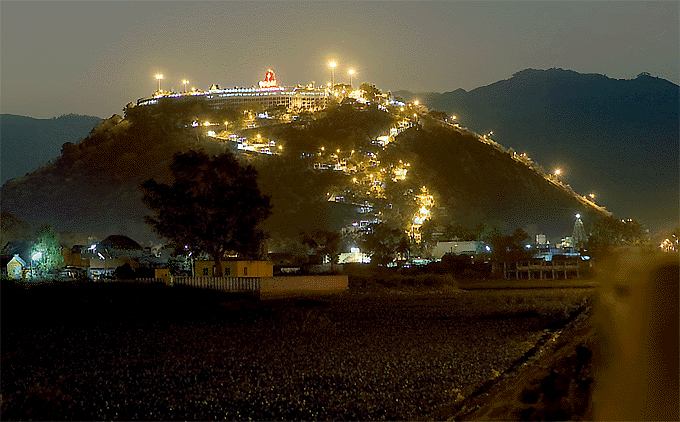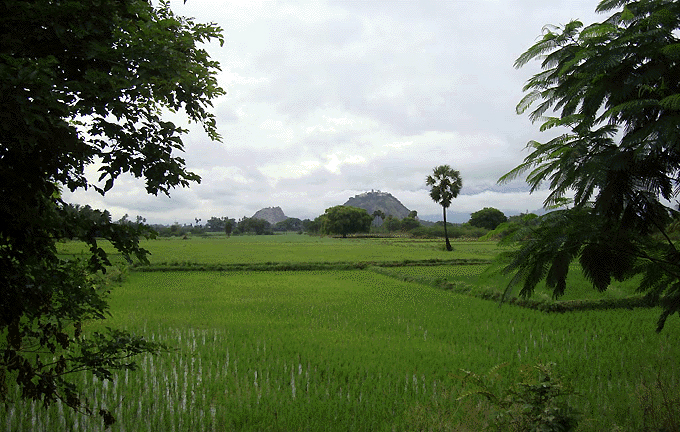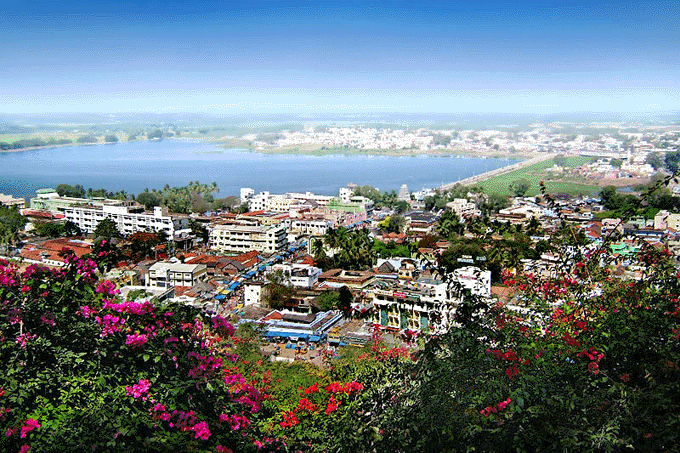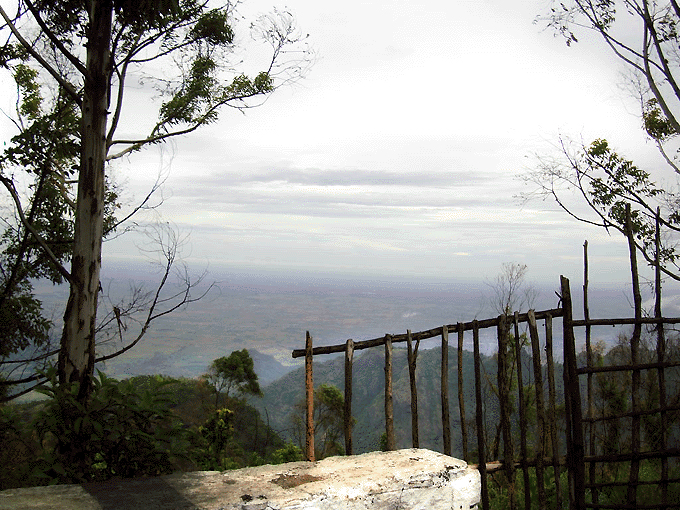
|
|
|
|
BY: SUN STAFF

Palani (Rsabha) Hill Feb 03, CANADA (SUN) — A serial exploration of the holy sites visited by Lord Caitanya. Rsabha-parvata
In the summary of Sri Caitanya-caritamrta Madhya lila 9, we read that Lord Caitanya's South India travels included a stop at Rsabha-parvata, a sacred hill near Madurai, Tamil Nadu:
"Finally the Lord went to Sri Ranga-ksetra, where He converted a brahmana named Venkata Bhatta, who, along with his family, became a devotee of Krsna. After leaving Sri Ranga, Caitanya Mahaprabhu reached Rsabha-parvata, where He met Paramananda Puri, who later arrived at Jagannatha Puri. Lord Sri Caitanya Mahaprabhu then proceeded farther, arriving at Setubandha Ramesvara." (Madhya lila 9 Summary) In Madhya lila 9.166-67 we read a brief description of Rsabha-parvata: Madhya lila 9.166-7
"When the Lord arrived at Rsabha Hill, He saw the temple of Lord Narayana and offered obeisances and various prayers. PURPORT Paramananda Puri was staying at Rsabha Hill during the four months of the rainy season, and when Sri Caitanya Mahaprabhu heard this, He immediately went to see him." Rsabha hill is also mentioned in the Srimad-Bhagavatam: "In the tract of land known as Bharata-varsa, as in Ilavrta-varsa, there are many mountains and rivers. Some of the mountains are known as Malaya, Mangala-prastha, Mainaka, Trikuta, Rsabha, Kutaka, Kollaka, Sahya, Devagiri, Rsyamuka, Sri-saila, Venkata, Mahendra, Varidhara, Vindhya, Suktiman, Rksagiri, Pariyatra, Drona, Citrakuta, Govardhana, Raivataka, Kakubha, Nila, Gokamukha, Indrakila and Kamagiri. Besides these, there are many other hills, with many large and small rivers flowing from their slopes." (Srimad-Bhagavatam 5.19.16, Translation) "There are other mountains beautifully arranged around the foot of Mount Meru like the filaments around the whorl of a lotus flower. Their names are Kuranga, Kurara, Kusumbha, Vaikanka, Trikuta, Sisira, Patanga, Rucaka, Nisadha, Sinivasa, Kapila, Sankha, Vaidurya, Jarudhi, Hamsa, Rsabha, Naga, Kalanjara and Narada." (Srimad-Bhagavatam 5.16.26, Translation) As Srila Prabhupada mentions in his purport to Madhya 9.166, the Rsabha hill visited by Lord Caitanya is commonly known today as the Palni or Palani Hill. Currently residing atop this prominent hillock is a Murugan (Kartikkeya) temple. A Kannadi Perumal Temple dedicated to Vishnu is situated on another hillock 9 km south of Palani, but we do not know what Narayana temple Mahaprabhu visited.

Murugan Temple on Palani Hill One of the most well known spots in the area today is the Kodaikanal hill station, from which a beautiful view is seen of the Palni range. The two most prominent hills are the Sivagiri and Sakthigiri, the Sivagiri being home to the Murugan temple. Under the rule of the Pandyan kings of Madurai in the first millennium A.D., the Nayaka were eventually given rule of the region by the Kings of Vijayanagar, in the 14th and 15th centuries, and this extended through the time of Lord Caitanya's visit. The ancient mountain range of Rsabha-parvata is an eastward extension of the Western Ghats. The Palni Hills adjoin the Anamalai range to the west, extending to the plains of Tamil Nadu. At their lower elevations, the Palni Hills are covered in moist deciduous forests which give way to evergreens, then montane, and diminishing grasslands.

Rsabha-parvata range at Kodaikanal There are numerous references to Rsabha-parvata in the Puranas. Devi Bhagavata and Astama Skandha mention it as being one of the twenty mountains on the four sides of Mount meru. In the Ramayana, there is a reference to Sugriva giving instructions to the army of monkeys going out in search of Sita. Sugriva refers to Rsabha mountain as being situated in the middle of the ocean of milk. (Valmiki Ramayana, Kiskindha Kanda, 4th Sarga, Verse 44). According to the Skanda Purana, Rsabha-parvata is situated to the south of Meru and to the north of Dugdha kunda, near a sacred lake known as Ramya sara. According to the Mahabharata, Rsabha-parvata stands in Pandya, where the hills are locally known as Baraha-parvata. The name Rsabha is found in many places throughout Vedic literature, beginning with Rsabha, the King of the Lunar Dyanasty, great grandson of Uparicaravasu. Mahabharata states that Rsabha fought within the Garudavyfiha formed by Drona. (Mahabharata, Drona Parva, Chapter 20, Verse 12) Rsabha was also the name of the 8th Lila Avatar of Krsna. The son of King Nabhi by his wife Merudevi, Rsabha was the progenitor of one hundred sons born to his wife Jayanti. After entrusting his kingdom to his eldest son Bharata, Rsabha went to the forest to perform tapas in Pulaha's asrama, remaining there for many years. This is described in Mahabharata, Aranya Parva, Chapter 11. The Visnu Purana, Chapter 1, Section 1, describes Rsabha's austerities in the forests of Rsabha-parvata. He became so thin that all the veins of his body could be seen. Taking a pebble in his mouth, he moved about in the forest, determined to renounce his body. Eventually a wild fire broke out, in which his body was burned up. The Siva Purana states that after the fire, Rsabha's soul attained Siva-loka.

Lowlands view of Rsabha-parvata Lord Caitanya's Pastime with Paramananda Puri at Rsabha-parvata
The forest fire that devoured Rsabha's body is also mentioned in biographical narratives of Lord Caitanya's parishad associate, Paramananda Puri: "When Mahaprabhu left Nilachala to do a tirtha-yatra of Southern India in the company of Krishna Das Vipra, he traveled through Kurmasthana, Jiyada-Nrisingha, Vidyanagara where he met with Raya Ramananda, Gautami Ganga, Mallikarjuna, Ahobala Nrisingha, Siddhabata, Skandhakshetra, Trimatha, Vriddhakashi, Bauddhasthana, Tirupati, Trimalla, Pana Nrisingha, Shiva Kaïci, Vishnu Kaïci, Trikalahasti, Vriddhakola, Shiyali Bhairavi, the banks of the Kaveri River, Kumbhakarna"s forehead, Shrirangam (where he bestowed bhakti on Vyenkata Bhatta and his entire family). When he arrived at Rshabha Mountain he met Paramananda Puri for the first time. Rshabha Parvata is in the state of Tamil Nadu in Madurai district. Twelve miles north of the town of Madurai are the Anagadamalaya mountains where Rshabhadeva was burned in a forest fire in the forest surrounding Kutakacalam. The place is known today as Palni Hill, or Varaha Parvata, according to the local people." (Chaitanya-caritamrita 2.9.171-3) ("Sri Chaitanya: His Life & Associates" by Srila Bhakti Ballabh Tirtha Maharaj)

View from Palani Hill In another biographical narrative on Paramananda Puri, we read: "The first meeting of Mahaprabhu and Paramananda Puri took place in South India at Rsabha Parvata. Mahaprabhu recited many prayers and hymns while taking darsana of Lord Narayana at Rsabha Parvata. Paramananda Puri was present there at that time for the four months of the rainy season (caturmasya). Hearing this auspicious news, Mahaprabhu went to meet him and offered his obeisances at his feet. Paramananda Puri in turn embraced Him in great love. For three days they remained absorbed in talks of Sri Krsna, staying together in Puri Gosai's room. Paramananda Puri told Mahaprabhu that he would be going to Purusottama (Puri) and then on to Gauda (Bengal) to take bath in the Ganges. Mahaprabhu then requested him to return from there to Nilacala as He would Himself be going there from Satubandha. Mahaprabhu expressed His desire that the two of them could reside there together. "Being kind upon me, please come to Nilacala." Saying this He took permission to leave and set out for the South, feeling very joyful. Then Paramananda Puri began his journey to Puri. According to Gaura-ganoddesa-dipika, Paramananda Puri was formerly Sri Uddhava in Krsna-lila." (Salagram.net) As with several of Sri Caitanya's tirtha-yatra visits covered thus far in the series, Lord Balarama and Nityananda Prabhu both visited Rsabha-parvata. In Srimad-Bhagavatam 10.79.11-15, we read about Lord Balarama's travels: "In the southern provinces known as Dravida-desa the Supreme Lord saw the sacred Venkata Hill, as well as the cities of Kamakosni and Kanci, the exalted Kaveri River and the most holy Sri-ranga, where Lord Krsna has manifested Himself. From there He went to Rsabha Mountain, where Lord Krsna also lives, and to the southern Mathura. Then He came to Setubandha, where the most grievous sins are destroyed."

View from Palani Hill And in Caitanya Bhagavata Adi lila, Chapter 9, we read of Nityananda Prabhupada's travels: "…Nityananda Prabhu went to Dravida. After visiting Vyenkattanatha, Kamakosti-puri, and Kanch, he arrived at the famed stream of the Kaveri and from there went to the holy place of Sri Rangam, where he stayed for some time. From there he went to Hari-ksetra, and then visited Mount Rsabha. Then he travelled to South Matura, Krtamala, Tamraparni, and then journeyed northward to the Yamuna, where he visited the home of Augustya on Malaya mountain."
| |